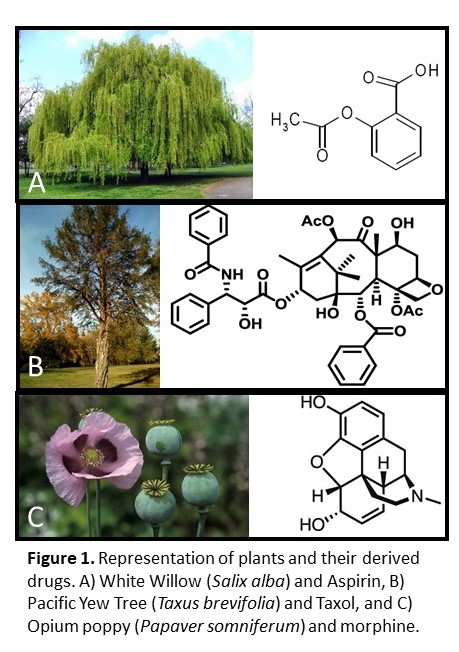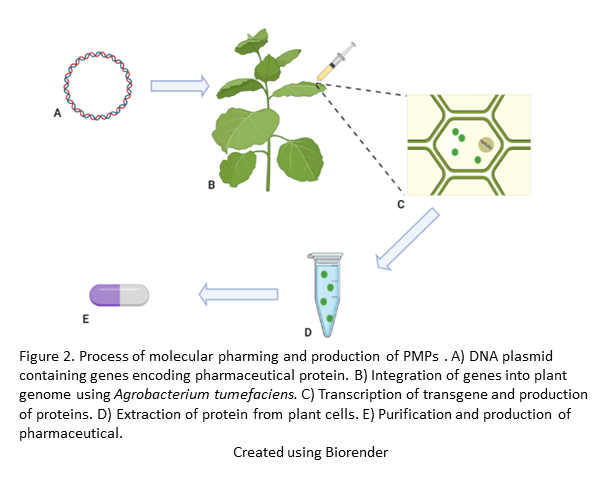
Red Meets Green Biotech: Plants in Medicine
Red Meets Green Biotech: Plants in Medicine
by Tawni Bull
Last time, we discussed the biotechnology rainbow and the general aspects and studies of each color. If you remember, I mentioned that green biotech was my favorite color. Plants are everywhere! In fact, if you look around you right now, I bet you find a few plants nearby. They are part of our everyday lives, yet most people do not realize how important plants are to humanity, and that they hold enormous potential for advancing many fields of science. Throughout the next few stories, I want to share how plants can and are being used in some of the different biotech branches. Let’s explore what happens when we mix green with the other colors of the biotech rainbow! For this story, we will focus on mixing green with red. How are plants used in the medical field to help fight chronic and infectious diseases?

Using fossil records, we can see that plants have been used in medicine for over 60,000 years, and today 80 percent of the world’s population uses medicinal plants in their primary healthcare (Chakraborty 2017). You may be thinking about herbal medicine such as teas and tinctures, but did you know they are used in common everyday medicines? For example, the chemical used to fight pain and inflammation in Aspirin is modeled after a plant chemical (phytochemical) found in white willow (Salix alba) bark. Also, the chemical in opiates such as morphine and codeine was originally discovered in the Opium poppy (Papaveraceae somniferum). What about more serious diseases such as cancer? Taxol, a common drug used in chemotherapy, is derived from the bark of the Pacific Yew Tree (Taxus brevifolia) (Figure 1.). The list goes on and on, plants are essential in routinely used drugs. A much larger list of drugs, their uses, and plant sources is available here.
Although we already have many plants being used for medicine, scientists are still in search of and testing potential plants for new drugs. This process is known as drug discovery. Plants synthesize an abundance of metabolites that have potential to be used in medicine. Most of these chemicals have yet to be discovered and characterized. Technologies such as genome sequencing are being used to help discover these new metabolic compounds and biproducts with hopes of finding a new drug to fight diseases such as HIV/AIDS and cancer. This is a fast-moving field with a wealth of information just waiting to be discovered!
Plants are also being used in a process called molecular pharming. This process consists of the production of chemicals and other pharmaceuticals using genetically engineered plants. Plants are engineered by inserting genes that will be transcribed and produce pharmaceutically important proteins, collectively known as plant made pharmaceuticals (PMPs). Figure 2 gives a brief description of this process. These PMPs include antibodies, enzymes, growth factors, and vaccines. Molecular pharming was first accomplished in the 1990s by producing human serum albumin, a protein found in human blood plasma, in the potato plant (Pany 2015). Today a common plant used in molecular pharming is Nicotiana benthamiana, a close relative of tobacco. A few examples of PMPs include antibodies against Streptococcus mutans, a bacterium that causes tooth decay, and anti-Herpes Simplex Virus. If you read the great blog written by Jed Bassein titled "How Do Antibody Therapies Work?" , you can now understand that plants are an important contributor in producing antibodies for these types of therapies.

The examples listed above only brush the surface of the importance of plants in medicine. They offer many advantages in the medical field and will continue to be studied for the advancement of medicine and drug discovery. Next time, we will explore how green biotech mixes with the water of blue biotech. Stay tuned!
References
Chakraborty, P. 2018. Herbal genomics as tools for dissecting new metabolic pathways of unexplored medicinal plants and drug discovery. Biochimie Open. 6:9-16.
Pany, S.S. 2015. Molecular Pharming: A Brief Review. Journal of Agricultural, Biological, and Environmental Sciences. 2:36-39.
Editor's Note
This is the second blog in an introductory series, "The Biotechnology Rainbow" aimed at middle school science students and educators, and non-specialist audiences. Author Tawni Bull has research expertise in plant-pathogen interactions, molecular biology and genomics through her work in the Michelmore Lab at the UC Davis Genome Center. Other blogs in the series include:
